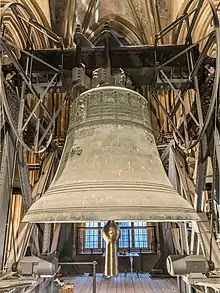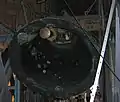Petersglocke
Saint Peter's bell (orig. German: Petersglocke [ˌzaŋkt ˈpeːtɐs ˌɡlɔkə]), referred to in the Colognian dialect as Decke or Dekke Pitter (Colognian: [ˌdekə ˈpitˑɐ] (![]() listen)) and in common parlance as Dicker Pitter (German: [ˈdɪkɐ ˈpɪtɐ]; i.e. "Fat or Big Peter"), is the largest bell in Cologne Cathedral. It was cast in 1923 by Heinrich Ulrich in Apolda and hangs in the belfry of the south tower. With a weight of approximately 24,000 kilograms (53,000 lb), a clapper weighing ~700 kilograms (1,500 lb) and a diameter of 322 centimetres (10 ft 7 in), it is the second largest (horizontally mounted) freely swinging ringable bell in the world, after the bell of the People's Salvation Cathedral.[1]
listen)) and in common parlance as Dicker Pitter (German: [ˈdɪkɐ ˈpɪtɐ]; i.e. "Fat or Big Peter"), is the largest bell in Cologne Cathedral. It was cast in 1923 by Heinrich Ulrich in Apolda and hangs in the belfry of the south tower. With a weight of approximately 24,000 kilograms (53,000 lb), a clapper weighing ~700 kilograms (1,500 lb) and a diameter of 322 centimetres (10 ft 7 in), it is the second largest (horizontally mounted) freely swinging ringable bell in the world, after the bell of the People's Salvation Cathedral.[1]

History
When the bell was cast in 1923, the bell-founder refused to take German marks as a payment because of the hyper-inflation. Instead the Cathedral Chapter paid 5000 US dollars. The predecessor of the bell was the "Emperor's Bell" (orig. German: Kaiserglocke) or Gloriosa ("Glorious") of 1873 which at 27,180 kilograms (59,920 lb) was even heavier than the St. Peter's bell. In 1918 it was melted down, because of the poor sound quality and the inadequate tone. Its metal was used for war purposes. During its thirty-year life it had regularly been put out of service to attempt to fix the inappropriate sound. Because of this the bell was nicknamed Große Schweigerin, or "big silence".
The crack
In 1951, a 110 centimetres (3.6 ft) long crack appeared on the bell. It was welded in 1956 by the company Lachenmeyer from Nördlingen. After repairs, the bell received a new, lighter clapper (approx. 600 kilograms [1,300 lb][2]), and it was rotated approximately 20 degrees so that the clapper did not strike the damaged area.
The broken clapper
On 6 January 2011, the clapper broke and dropped on the floor below. The four earthquake sensors in the cathedral registered it. As it could not be repaired, a new one was cast and was installed in December of the same year. It was later discovered that the accident happened because the clapper had not been correctly installed in the 1950s, thus increasing wear, which consequently led to material degradation. The new clapper weighs approx. 600 kilograms (1,300 lb) and is 3.20 metres (10 ft 6 in) long. It was installed on 2 December 2011, and was first rung on 7 December 2011. The workers installed two new electric ringing engines (500 rpm), who harmonized with the new clapper. The old engines worked with 750 rpm.[3]
Ringing ordinance
The bell is only rung on special occasions and on solemnities (s. u.).[4] The declaration or death of an Archbishop of Cologne or of a Pope, as well as the investiture of a new archbishop also warrant tolling St. Peter. All bells of the cathedral rang on the eve of 28 March 1936, a Friedensappell ("peace appeal") of Hitler, which he made in Cologne due to the Reichstag elections.[5] Likewise, the St. Petersglocke declared the end of World War II above the ruins of the city of Cologne in 1945, and in 1990 the reunification of Germany. As a rule, St. Petersglocke rings solo for ten minutes before all the others, which join in accordance with the general ringing ordinance. However, not all South Tower bells will be rung every time. For the Feast of the Immaculate Conception bells 1–6 are rung and for the Christmas Eve Vigil bells 1–3.
| Date/Day | Time | Reason |
|---|---|---|
| 7 December | 19:30 | Pre-Ringing for the Solemnity of the Immaculate Conception of the Blessed Virgin Mary[6] |
| 8. December | 09:35 | Solemnity of the Immaculate Conception of the Blessed Virgin Mary (Sundays) |
| 18:05 | Solemnity of the Immaculate Conception of the Blessed Virgin Mary (Weekdays) | |
| 24 December | 19:15 | Pre-Ringing for the Solemnity of the Nativity of the Lord on Christmas Eve |
| 23:05 | Christmas Vigil on Christmas Eve (together with the Pretiosa and Speciosa) | |
| 25 December | 09:35 | Christmas Day |
| 1 January | 00:00 | Pre-Ringing for the new Year (Full chimes) |
| 5 January | 19:30 | Pre-Ringing for the Solemnity of the Epiphany of the Lord |
| 6 January | 09:35 | Epiphany of the Lord/Three Kings' Day |
| Holy Saturday | ≈23:15 | Glory of Easter for the Easter Vigil (Full chimes) |
| Easter Sunday | 09:35 | Resurrection of the Lord |
| Eve of Ascension Day | 19:30 | Pre-Ringing for Ascension Day |
| Ascension Day | 09:35 | Solemnity of the Ascension of the Lord |
| Pentecost Eve | 19:30 | Pre-Ringing for the Solemnity of Pentecost |
| Pentecost | 09:35 | Solemnity of Pentecost |
| Eve of Corpus Christi | 19:30 | Pre-Ringing for the Solemnity of Corpus Christi[7] |
| Corpus Christi | 09:35 | Solemnity of Corpus Christi |
| Procession and Entrance of the Blessed Sacrament | Solemnity of Corpus Christi (rung solo) | |
| 28 June | 19:30 | Pre-Ringing for the High/Patronage Feast of St. Peter and Paul |
| 29 June | 09:35 | High/Patronage Feast of St. Peter und Paul (Sunday) |
| 18:05 | High/Patronage Feast of St. Peter und Paul (Weekdays) | |
| 31 October | 19:30 | Pre-Ringing on All Hallows Eve[8] |
| 1 November | 09:35 | All Hallows/All Saints' Day |
Gallery
 On this image the damaged area from the crack can be seen to the left of the clapper
On this image the damaged area from the crack can be seen to the left of the clapper The Peter's bell with the broken clapper
The Peter's bell with the broken clapper The Peter's bell with the new clapper
The Peter's bell with the new clapper The Peter's Bell without a clapper
The Peter's Bell without a clapper
References
- Wamsiedler, Sebastian (13 April 2017). "Rekord gefallen - Größte freischwingende Glocke der Welt zukünftig nicht mehr in Köln |" [Record broken - Largest free-swinging bell in the world will no longer be in Cologne]. www.wamsiedler.de (in German). Retrieved 30 November 2018.
- "Archived copy". Archived from the original on 11 February 2016. Retrieved 14 December 2015.CS1 maint: archived copy as title (link)
- "Neuer Klang für die Kölner - Dicker Pitter läutet wieder - YouTube". www.youtube.com. Retrieved 24 December 2020.
- www.koelner-dom.de: Läuteordnung 'Dicker Pitter' Archived 18 July 2014 at the Wayback Machine
- Apoldaer Tageblatt, 27 March 1936.
- Einläuten zu Maria Empfängnis (7 December 2006): Teil 1; Teil 2.
- Einläuten zu Fronleichnam (6 June 2007): Teil 1; Teil 2; Teil 3.
- Einläuten zu Allerheiligen (31 October 2006): Teil 1; Teil 2; Teil 3.
